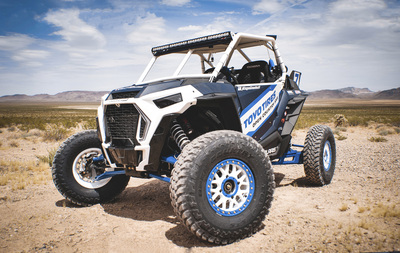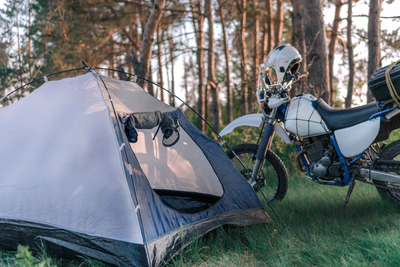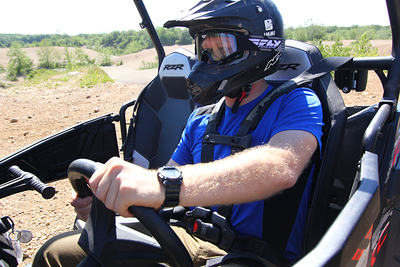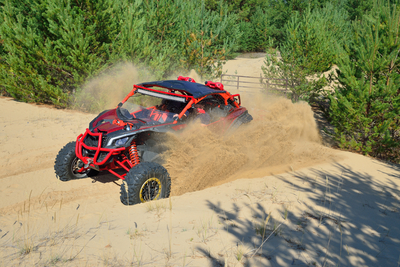BUSINESS
Ripe for Opportunity
Fueled by Record Demand, the Powersports Market Explodes, Crossing Into the Mainstream
By Chad Simon

By moving to a more capable tire such as the Toyo Open Country SxS, users can feel more comfortable in handling whatever terrain they come across.
Powersports sales have been on fire, dramatically increasing across the board since 2020, but resulting in part of the supply-chain woes we’re constantly reading about in the news. The culprit: enthusiasts and even ordinary people desperately seeking adventure to distract themselves or reemerge from the COVID-19 doldrums.
These have been two of the better years in recent times for motorcycle, ATV and UTV (aka side-by-side) dealers, manufacturers and even the aftermarket. Because consumers haven’t been traveling as much, have extra money to spend and, in many cases, work from home, they’ve had more time to spend outdoors.
Breaking the Chain
However, the supply-chain conundrum has limited the number of vehicles being manufactured, which has required dealerships to turn to preordering, according to Dave McMahon, content director for PowerSports Business magazine. In the past, dealers may have had stacks of ATVs sitting in the parking lot waiting to get into the showroom. With a gap in dealer inventory, demand is far outpacing supply. Now, every unit is often already presold and out the door. Dealers have had to adapt to a whole new way of doing business.
The supply-chain meltdown is also preventing manufacturers from getting parts to finish their products, and everybody in the powersports industry is feeling the heat.
“Shock absorber manufacturers are missing a couple of pieces, and they can’t get product off the shelves because they’re not completed yet,” said Jim Ryan, marketing and sales director for SCORE International. “It’s little things that are causing tremendous wait orders.”
Not to be outdone by UTVs, motorcycle sales have increased almost 22%, thanks in large part to economic stimulus money and low interest rates, according to Carl Parker, owner/publisher of ADVMoto magazine.
“Dealers are selling out of all kinds of vehicles, from two to four wheels,” Parker said. “They’re selling at retail-plus and sometimes even retail-plus-plus. In the motorcycle industry, we’ve found a heavy emphasis on smaller, beginner-oriented bikes. Many people are buying them—not just new riders but also experienced riders who are shifting to smaller models.”
The COVID-19 Factor

Whether you’re camping on a motorcycle or sleeping in a van, exploring the world doesn’t require a lot of money if you’re willing to live without some comfort and
convenience. Photo credit: Shutterstock.com
COVID-19 forced people to get outside to spend time with their families, so the pandemic has been a boon to business for motorcycle, ATV and side-by-side manufacturers and dealers.
“Dealerships have had their best couple of years ever because people are just looking for something to do,” McMahon said. “That might mean buying a first motorcycle and learning how to ride. Or maybe you have an ATV and now you buy a side-by-side to take the family out. A lot of that has changed now, but at the onset of the pandemic, dealers told us that’s what drove much of the sales.”
According to Ryan, the pandemic blew everything up in a positive way. Dirt-bike sales—which had been in decline for years—suddenly took off, so the demand caused by COVID led to orders being placed at record levels not only with racing but also lifestyle usage. Trophy Truck teams have a number of UTVs that are used extensively throughout racing and enthusiast-based activities.
Parker added that for aftermarket accessories, there’s been more of a shift to internet purchasing because some stores either were not open during the early days of the pandemic or people who sold at events and expos were shut down, forcing consumers to go online.
“It was positive in a sense, but it was a double-edged sword,” he said. “Many providers didn’t know how the pandemic would affect them, so some of them went shy on inventory, thinking there was going to be an economic collapse. The recreational markets then blew up because people began to realize that life was short and there was no better time to be happy than right now. The market surge left a lot of people out of supply. They ended up having to turn away customers, which you never want
to do.”
What’s Trending
From SCORE’s perspective, Ryan said that UTVs have assumed more duties than the first utility vehicles built many years ago. Today they’re found in top-level motorsports and enthusiast programs, and they’re even used for agricultural applications and have overlanding capabilities. In terms of trends, their usage just keeps growing into other lifestyle categories; it’s not just racing.
McMahon estimated that approximately two out of three side-by-sides are used for work, recreation or utility. A small ranch owner might use one to mend fences because it’s more maneuverable than a pickup. Folks are also hitting the trails in UTVs, and some counties even consider them suitable for on-road use. However, the lack of nationwide laws allowing on-road usage is among the UTVs’ biggest limitations.
The other third of UTV users is the performance and aftermarket crowd—the go-fast machines that are found out on the dunes and in wide-open spaces. The creature comforts that side-by-side manufacturers offer are a big hit among enthusiasts.
“You hop into your side-by-side when you go ice fishing in Minnesota, and it’s a fully enclosed cab with automatic windows, full heat and air conditioning,” McMahon said. “The comfort level that some of these manufacturers are providing goes beyond what a customer would have expected they’d be able to get coming into the market for the first time during the pandemic. There are so many different accessories and features that can make their outdoor experience more enjoyable.”
The vehicles also get bigger and stronger every year, pushing the limits of what the machines can do, according to Larry Gray, sales manager for IMMI—a safety restraint supplier of three-point and multi-point harnesses to both OEMs and the aftermarket. Side-by-sides have hit their power threshold, Gray said, and because of that, the focus will trend toward upgrading the vehicle’s interior.
Especially among older enthusiasts, there tends to be a large crossover demographic between off-road riding, motorcycling and off-road four-wheeling with UTVs.
“Because of the cost of the new UTVs, you’re generally looking at a slightly older demographic, closer to retirement age,” Parker said. “They have the money, and many of them have both motorcycles and side-by-sides in their garages. It’s not like they’re giving up on one and going to the other or vice versa. These types of vehicles actually complement each other, and there’s a buyer’s market for both of them. Consumers want to be able to explore the world off-road, and both have their own merits. I’d be willing to bet that many of the off-road side-by-side enthusiasts also have dirt bikes in their garages.”
The bottom line is that powersports enthusiasts just want to get dirty and explore, whether on a side-by-side or motorcycle. Both new and used adventure dual-sport bikes are doing extremely well, and so are the aftermarket parts and accessories for them, Parker said. Items such as clothing and hard parts are in short supply, including helmets, armor and gear.
“We expect this trend to continue as people move away from a traditional employment environment to more flexible work duties and conditions,” Parker said. “More people are working from home now, and some have left jobs that they were fundamentally unhappy with. They’ve rearranged their lives to make due with fewer resources and focus more on doing things they want to do.”
Aftermarket Opportunities

According to the 2021 SEMA Market Report, 34% of U.S. consumers own at least one powersports vehicle, of which nearly half will accessorize.
With the advent of UTVs, especially in the last half-dozen years or more, there’s an entire aftermarket specifically focused on that space because it’s lucrative.
“At the MPMC [Motorsports Parts Manufacturing Council] Media Trade Conference, we’re having many first-time conversations with manufacturers in terms of the UTV market, what they’re targeting for 2022, what they’ve developed and what they’re releasing this year to get involved in that market,” Ryan said.
The traditional side-by-side aftermarket parts companies are ramping up their product lines, continuing to innovate and building products that are cooler-looking, faster and lighter, McMahon stated.
“Over the last couple of years, we’ve seen companies that started out in motorcycle aftermarket parts and accessories,” McMahon said. “They’re seeing the growth and wanting a piece of the pie, so they’ve gotten into the side-by-side aftermarket space also. They’re not at the same volume as some of the established players, but they’re also side-by-side enthusiasts, which has allowed them to broaden their businesses.”
The side-by-side market quickly jumped from what could be described as glorified off-road go-karts to extremely capable and highly equipped off-road machines, according to Cameron Parsons, product engineer and field analyst for competition and specialty tires at Toyo Tire U.S.A. Corp. The market has blown up not only among enthusiasts but also in the mainstream. Many customers now look for convenience and comfort to complement their fun. They demand features that make their expeditions easier and more comfortable, because they don’t want to get stuck in the middle of nowhere with their spouses and kids.
According to Parker, anyone who can deliver a competent product can do well, but some aspects are worth considering.
“My number-one tip is to look at developing and innovating cross-purpose or universal products,” he said. “There’s a motorcycle luggage company that also started making fuel bags, which have massive applications across all segments. Forward thinking like that is important.
“Also, keep an eye on developing a product that allows the application of other gear on similar or slightly different platforms. For example, many people might have a motorcycle that has luggage. How about having crossbar members on a UTV or side-by-side that simply allow you to use that same luggage? The size is really not all that different. It doesn’t matter what vehicle you put it on insofar as you are able to install it in a safe and secure manner. Focusing on those things will add a little bit of promise. I don’t see these types of products being over-emphasized.”
Common Upgrades

Harnesses such as the IMMI Click6 are popular upgrades among UTV enthusiasts.
What the Jeep is for the on-highway vehicle, ATVs and UTVs are for the off-highway vehicle in terms of how easy they are to customize. Rooftops, winches, bumpers, sound systems and engine performance components are among the first modifications consumers make. Restraint systems (including harnesses and rollcages) are also popular upgrades, Gray observed.
Parsons said that most side-by-side customers intend to take full advantage of their new vehicles’ capabilities, so many early upgrades revolve around comfort, durability and performance. Popular comfort items include seats, lighting and windshields.
On the function and durability side, it’s common for users to install bolt-on components that are available off the shelf and are easily installed. That includes suspension upgrades related to springs, dampers and anti-roll bars. Basic drivetrain and power add-ons such as intakes and exhaust are also on the list, plus stronger clutch components and a few spare belts, since that is a common point of failure across the board.
“Protection is a big deal to many new owners who want to take care of their equipment, so you’ll find lots of new side-by-sides carrying skidplates, bumpers and nerf bars,” Parsons said. “Finally, wheels and tires serve as style items that also improve vehicle performance. By moving to a more capable and often taller tire, users can feel more comfortable in handling whatever terrain they come across. They want confidence in exploring new paths and playing harder in the dirt, because a part failure can make for a major damper on a fun trip. A capable and reliable tire is one of the most important components to not cheap out on.”
From the two-wheel, dual-sport and adventure side, crash bars, armor, luggage and electronics are common upgrades, according to Parker. Performance-wise, many motorcycle enthusiasts go for exhaust (mostly for the improved sound and weight reduction), followed by comfort products such as saddles, bar risers and lowering pegs.
While more people stick with stock wheels on their motorcycles, side-by-side consumers like to buy extra wheels, and side-by-sides also offer more options than motorcycles because they can be outfitted with four-speaker sound systems that normally aren’t found on off-road bikes.
Vehicle Evolution
Between chassis designs, suspension packages and engines and drivetrains, UTVs are becoming more robust in every way. On the racing side, manufacturers continue to introduce new products. For example, the next-generation Polaris has a larger-size engine, and all of the OEMs are following suit, Ryan claimed.
“For our world, this is the factory wars—Polaris, Can-Am and Robby Gordon Speed units,” Ryan said. “They’re full-race production models, and that’s where the money is. It’s not Ford, Chevy, Dodge or Toyota anymore. It’s now come down to the UTV class. They’re still racing vehicles you can buy in the showroom.”
The spectrum is widening for motorcycles, and it’s not just about size and power, according to Parker.
“The adventure dual-sport models have evolved over the past 10 years,” he said. “Most of the basic dual-sport models that have been around since the ’90s have been updated, while others have been replaced with newer models. There are also smaller bikes available on the market, such as the KTM 390, Himalayan, 300cc or 500cc adventure bikes, and they all sell out. They’re more like companions and are good for multi-use riding, whether on- or off-road.”
Midsize bikes—anywhere from around 450cc up to 1,000cc—have seen more emphasis because people who ride larger bikes are finding that lighter ones perform better off-road, according to Parker. They’ll come from a 1,200 down to a 600, 700 or 800.
“The Yamaha Ténéré 700 is fantastic, but you can’t get one because they’re in short supply,” he said. “Kawasaki just reintroduced a heavily revised KLR650, which is doing well. Many people are still into the large bikes, which have really evolved. They have all the bells and whistles that you can hope for. KTM, Triumph, BMW, Honda, Yamaha and Suzuki all have good options in the 1,000cc-plus category.
“You can change your ABS front and rear balancing, add heated seats, heated grips, an electronic windscreen, fullsize TFT displays and different levels of traction control. Harley-Davidson has shocks that can raise and lower the bike. They are technologically advanced and push the limits of motorcycle technology, both in fun and safety, and not just in off-road. Many of the sport-touring riders have been buying large adventure bikes because they’re also more comfortable.”
Appealing to New Consumers

The performance and aftermarket crowd comprises about a third of the overall UTV market. These are the go-fast machines that are found out on the dunes and in wide-open spaces. Photo credit: Shutterstock.com
Riding is a ticket for people to get outside and see things they haven’t seen before. They can go out and explore nature from a different perspective than by bicycle or foot, according to Gray.
Women are increasingly becoming involved in powersports. In fact, one out of every five motorcycle riders is a female, McMahon said. The base-level UTVs are ideal for families because they can carry between four to six passengers, and the vehicles are safer because occupants are enclosed in a cage.
“UTVs are pretty well set up from the factory,” Ryan said. “There are great training grounds, and that’s where many people get their first taste of off-roading now. It’s not dirt bikes like we all grew up with. The UTV market has definitely cannibalized the dirt-bike side of the powersports market, because that’s where families have gone.”
The number of UTV models to choose from range from very low-key to high end, and there are many variations in between. There’s also price point—$30,000 for a full turnkey vehicle versus an $80,000 truck.
“From a side-by-side standpoint, it’s easy to not do it alone,” McMahon said. “If the guys are going out and want to bring the wife or girlfriend, the four-seat configurations allow more friends and family to get involved. If you’ve ever driven a car, you’re going to be familiar with the steering wheel and the gas and brake pedals; it’s not a situation where you’re getting on a motorcycle and you’re less familiar with it. We’re hearing from dealers that people who might have bought at the onset of COVID are coming back in and looking to get an aftermarket part or accessory—something different to spice things up on the ride by adding a little more comfort and speed.”
Meanwhile, the adventure dual-sport segment is appealing for several reasons. First, they’re practical, and people of all ages are focusing more on having cool life experiences.
“You can do many things on these bikes, whether for fun, commuting or world travel,” Parker said. “If you just want to explore the back roads around your area, you can do that. If you want to go to work on it or get groceries, you can do that. If you want to set off and go around the planet on it, you can do that, too. A lot of motorcycles, except for some of the street bikes, weren’t as practical as they were fun. Adventure is exciting and even romantic, and these bikes can do it all.”
Whether you’re camping on a motorcycle or sleeping in a van, exploring the world doesn’t require a lot of money if you’re willing to live without some comfort and convenience.
“The socioeconomic spectrum for this has widened,” Parker said. “Much of it has been bolstered by do-it-yourself or minimalist thinking. If you want to buy a motorcycle or a side-by-side and throw a lot of cash at it, you can do that. You can get some sick rides and nice gear that’s going to make your navigation easier and your life more comfortable, safer and fun. But if you have a shoestring budget, you can buy a used bike and test your ingenuity. People who become interested in the hobby and enter the secondhand market often end up upgrading and moving through the market, and that’s
important.”
Future Outlook
The powersports market has a bright future with plenty of opportunities for continued growth. Side-by-sides in particular offer an exciting and adventurous way for people to spend time with their families and friends outdoors. The hobby has become a lifestyle, and as young kids grow up with UTVs, they will continue to participate in the lifestyle.
“This is a good spot to be in, whether you’re a vehicle manufacturer, a dealer, or are in aftermarket parts and accessories,” McMahon said. “If I was one of those players, I’d be confident in the next couple of years. That experience and adventure is going to be around, and as more people become aware of it, they’re going to want to experience it, too.”
According to Ryan, some new manufacturers are starting to push the bar a little higher in terms of turnkey race products. The used UTV market is already booming because the new models are slower to come out due to COVID-19-related supply-chain issues.
The outlook for the adventure dual-sport market also looks bright for now; however, Parker believes we’re headed for another economic downturn.
“We’ve got high inflation, sky-high real estate values and a Fed that will likely raise interest rates several times in 2022,” he said. “If you look back at 2008, the powersports industry got hit pretty hard by economic changes. Notably, banks got tight on issuing loans, which put a serious dent in new-vehicle sales. But unlike 2008, our current dilemma comes on the back of COVID-19, which created many societal changes.”
For instance, those who bought more affordable vehicles and had a shoestring mentality have already trimmed down on many of their excessive needs, Parker added. They’ve already been pushed to a certain limit and are unlikely to be willing to go any further.
“Ten years ago, there was a custom chopper craze,” he said. “That was kind of a fad. It was cool while it happened, but it didn’t last forever, so we saw a market reversal on those. When you have a bad economy and a $25,000 vehicle sitting in the garage that’s not being used, the mortgage, food and kids usually win. It’s possible that there may be a reversal on market demand for some of the more expensive vehicles over the next few years, but that doesn’t mean that it’s bad news for the aftermarket.
“People often buy these vehicles secondhand, and they want to do their own thing to them. It’s been used a bit, but they’re getting a great price on it. They’re going to need shocks and so on and so forth, but all of that depends on how well we handle any upcoming market and economic changes as a unified industry and also how well the feds navigate what really looks to be like a rough couple of years coming down the road.”
SOURCES
ADVMoto
4000 Legato Rd., Ste. 1100
Fairfax, VA 22033
571-485-2910
https://adventuremotorcycle.com
IMMI
18881 IMMI Way
Westfield, IN 46074
317-896-9531
www.imminet.com
PowerSports Business
10405 6th Ave. North, Ste. 210
Minneapolis, MN 55441
763-383-4492
https://powersportsbusiness.com
SCORE International
465 S. Meadows Pkwy. #6
Reno, NV 89521
775-453-4971
https://score-international.com
Toyo Tire U.S.A. Corp.
5665 Plaza Dr. #300
Cypress, CA 90630
714-236-2080
www.toyotires.com






